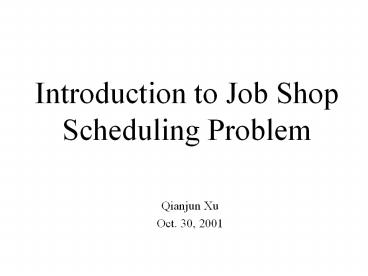Introduction to Job Shop Scheduling Problem - PowerPoint PPT Presentation
Title:
Introduction to Job Shop Scheduling Problem
Description:
Introduction to Job Shop Scheduling Problem. Qianjun Xu. Oct. 30, 2001. Description of Job Shop Scheduling. A finite set of n jobs ... – PowerPoint PPT presentation
Number of Views:1431
Avg rating:3.0/5.0
Title: Introduction to Job Shop Scheduling Problem
1
Introduction to Job Shop Scheduling Problem
- Qianjun Xu
- Oct. 30, 2001
2
Description of Job Shop Scheduling
- A finite set of n jobs
- Each job consists of a chain of operations
- A finite set of m machines
- Each machine can handle at most one operation at
a time - Each operation needs to be processed during an
uninterrupted period of a given length on a given
machine - Purpose is to find a schedule, that is, an
allocation of the operations to time intervals to
machines, that has minimal length
3
Formal Definition of JSS
- Job set
- Machine set
- Operations
- Each operation has processing time
- On O define A, a binary relation represent a
precedence between operations. If
then v has to be performed before w. - A induce the total ordering belonging to the same
job no precedence exist between operations of
different jobs.
4
Formal Definition of JSS cont.
- A schedule is a function
that for each operation v defines a start
time S(v). - A schedule S is feasible if
- The length of a schedule S is
- The goal is to find an optimal schedule, a
feasible schedule of minimum length.,
min(len(S)).
5
Disjunctive Graph
- An instance of the JSS problem can be represented
by means of a disjunctive graph G(O, A, E). - The vertices in O represent the operations
- The arcs in A represent the given precedence
between the operations - The edge in
- represent the machine capacity constraints
- Each vertex v has a weight, equal to the
processing time
6
Example of Disjunctive Graph
7
Disjunctive Graph with Edge Orientations
8
Disjunctive Graph Cont.
- Finding an optimal feasible schedule is
equivalent to finding an orientation E that
minimizes the longest path length in the related
digraph.
9
Why JSS Problem
- It is considered to be a good representation of
the general domain and has earned a reputation
for being notoriously difficult to solve - JSS is considered to belong to the class of
decision problems which are NP - Lenstra et al(1977) Show that
- 33 problem
- N2 instance with no more than 3 operations per
job - N3 problem with no more than 2 operations per
job - N3 problem where all operations are of unit
processing time - Belong to the set of NP instances.
10
Methods to Solve JSS
- Mathematical Formulations
- mixed integer linear programming (1960)
- Branch and Bound
- Approximation Methods
- Priority dispatch rules
- Bottleneck based heuristics
- Artificial intelligence(constraint satisfaction
approach, neural networks) - Local search methods
-
11
Branch and Bound
- Using a dynamically constructed tree structure
represents the solution space of all feasible
sequences - Search begins at topmost node and a complete
selection is achieved once the lowest level node
has been evaluated - Each node at a level p in the search tree
represent a partial sequence of p operations - From an unselected node the branching operation
determines the next set of possible nodes from
which the search could progress - The bounding procedure selects the operation
which will continue the search and is based on an
estimated LB and currently best achieved UB. IF
at any node the estimated LB is found to be
greater than the current best UB, this partial
selection and all its subsequent descendants are
disregarded.
12
Priority Dispatch Rules
- At each successive step all the operations which
are available to be scheduled are assigned a
priority and the operation with the highest
priority is chosen to be sequenced. - Usually several runs of PDRs are made in order to
achieve valid results.
13
Constraint Satisfaction Approach
- Aiming at reducing the effective size of the
search space by applying constraints that
restrict the order in which variables are
selected and the sequence in which possible
values are assigned to each variable - Constraint propagation
- Backtracking
- Variable heuristic
- Value heuristic
14
Neural Networks
- Hopfield networks
- Back-error propagation networks
15
Local Search Method
- Configurations a finite set of solutions.
- Cost function to be optimised.
- Generation mechanism, generating a transition
from one configuration to another. - Neighborhood, N(x), is a function which defines a
simple transition from a solution x to another
solution by inducing a change. - Selection of neighborhood
- chose the first lower cost neighbor found
- select the best neighbor in the entire
neighborhood - Choose the best of a sample of neighbors.
16
Summary
- The definition of JSS
- The disjunctive graph
- The methods to solve JSS































